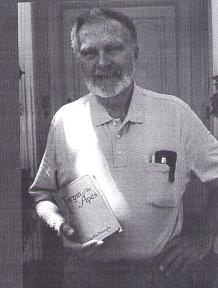 I
first met Lee Chase at his son Steven's home in Tucson, Arizona, on December
24, 2000. At that time he graciously shared with me some home movies made
by his mother, silent film actress Florence Gilbert, in the late 1930s
and early 1940s during her marriage to Edgar Rice Burroughs. Lee gave a
running commentary while the film played and I watched enthralled as animated
images of our favorite author with family and friends, against a background
of California and Hawaii, carried us back in time. Lee Chase was nearing
his sixth birthday when his mother and Ed Burroughs were married in April,
1935. Lee's memories of ERB date from the time he was approximately age
six to about age twelve, the years of his mother's and Ed's marriage: 1935
to 1942.
I
first met Lee Chase at his son Steven's home in Tucson, Arizona, on December
24, 2000. At that time he graciously shared with me some home movies made
by his mother, silent film actress Florence Gilbert, in the late 1930s
and early 1940s during her marriage to Edgar Rice Burroughs. Lee gave a
running commentary while the film played and I watched enthralled as animated
images of our favorite author with family and friends, against a background
of California and Hawaii, carried us back in time. Lee Chase was nearing
his sixth birthday when his mother and Ed Burroughs were married in April,
1935. Lee's memories of ERB date from the time he was approximately age
six to about age twelve, the years of his mother's and Ed's marriage: 1935
to 1942.
I took some notes and we had some still photographs made
from the videotape that the original Brownie 16mm movies had been transferred
to. The idea being that I would write a piece for The Burroughs Bulletin
based
on Lee's reminiscences along with several of the movie stills. Later, after
examining my notes, I realized that more information would be needed. In
July, 2001, I telephoned Lee Chase and he invited me to his home in Los
Angeles to conduct a formal interview. The results of our tape recorded
conversation of July 10, 2001, together with my earlier notes of December,
2000, are contained in the following passages. On behalf of the Burroughs
Bibliophiles I want to extend my warmest thanks to Lee Chase, his wonderful
wife Suzanne and son Steven for their friendship and hospitality extended
to me in Tucson and Los Angeles.
FRANK: When and where were you born, Lee?
LEE: I was born Lee Ashton Dearholt III at Hollywood Presbyterian
Hospital on the corner of Fountain and Vermont Ave. -- it's still standing
by the way -- on June 4, 1929.
FRANK: And you were the child of . . .?
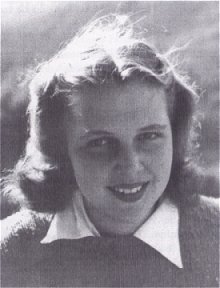 LEE:
The first child of Ashton Dearholt and Florence Gilbert Dearholt. I have
a sister named Caryl Lee, she goes by "Cindy" now but her birth certificate
would read Caryl Lee Dearholt.
LEE:
The first child of Ashton Dearholt and Florence Gilbert Dearholt. I have
a sister named Caryl Lee, she goes by "Cindy" now but her birth certificate
would read Caryl Lee Dearholt.
FRANK: What was your career?
LEE: Real estate development and management. I graduated
from USC in real estate and went on forty-one, almost forty-two years in
the field, everything from Hawaii to Saudi Arabia. I retired a few years
ago and now I'm enjoying traveling and my antique cars. I'm a member of
the Model T Ford Club of Southern California and also the national Model
T Club, the Model A Club, and a few others.
FRANK: That sounds like a lot of fun. Did you serve in
the military?
LEE: Yes. Our gang graduated from high school in 1948.
We had two years of college when the summer of 1950 hit and, of course,
the Korean War. So, boy, I tell you, we were prime and the draft notices
were flying. All of us went off and joined something or another. I spent
three and a half years in the Air Force as a radar observer. From Detroit
Municipal Airport we flew C119 radar planes on the early warning line over
Canada looking for Russian bombers coming across the North Pole.
FRANK: How did you and Suzanne meet?
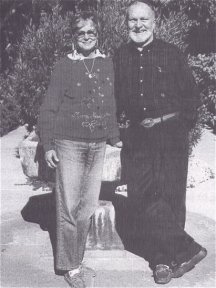 LEE:
Suzanne and I met in high school. She went to Marlborough School here in
Los Angeles; I was at L.A. High. We dated off and on for years and, finally,
in 1953 on Valentine's Day we were married. We've been married forty-eight
and a half years, currently.
LEE:
Suzanne and I met in high school. She went to Marlborough School here in
Los Angeles; I was at L.A. High. We dated off and on for years and, finally,
in 1953 on Valentine's Day we were married. We've been married forty-eight
and a half years, currently.
FRANK: What are some of your early memories of Edgar Rice
Burroughs?
LEE: Well, of course, there are many. "Ebbie" -- as we
called him -- was a very exciting guy, very dynamic, very social, always
giving parties and going to parties. Sometimes the kids would go along
but usually not. He was adventurous and, of course, had all the toys: a
Cord automobile, a Packard sedan, also a "woodie" for running errands.
The one I like was the Pierce Arrow roadster with a rumble seat. He was
very nice as a father. Certainly, he was a generous person. We always had
the best of everything.
FRANK: Do you recall his work habits?
LEE: When we went to Hawaii, I can remember when we lived
at Kailua Bay, that he would work in the mornings in a little room at the
back of the garage that he'd put his office in. He had his typewriter set
up on a wooden packing crate that we'd shipped things over from the mainland
in. He would write from, oh, eight o'clock in the morning, I'd say till
noon. He was not to be disturbed. Then in the afternoon he would take off
and play tennis or swim or other forms of recreation. Sort of an ideal
life.
FRANK: Did you enjoy living in Hawaii?
 LEE:
Very much so. We, of course, went to school over there, at Punahou. But
everyone pretty much knew the war was coming. They didn't know when and
they didn't know where - but they knew we were going to have problems.
We had practice blackouts. I remember even at school we had our little
bags with soap and a blanket and stuff, in case we had to stay overnight.
Then, when it looked like things were really heating up, we came home.
Went over on the S.S. Lurline, and came home on the S.S. Mariposa,
two of three ships that the Matson Line was running then. The Monterey,
the
Mariposa
and
the Lurline, which were pretty fancy boats in those days.
LEE:
Very much so. We, of course, went to school over there, at Punahou. But
everyone pretty much knew the war was coming. They didn't know when and
they didn't know where - but they knew we were going to have problems.
We had practice blackouts. I remember even at school we had our little
bags with soap and a blanket and stuff, in case we had to stay overnight.
Then, when it looked like things were really heating up, we came home.
Went over on the S.S. Lurline, and came home on the S.S. Mariposa,
two of three ships that the Matson Line was running then. The Monterey,
the
Mariposa
and
the Lurline, which were pretty fancy boats in those days.
FRANK: According to Irwin Porges' biography, Edgar
Rice Burroughs: The Man Who Created Tarzan, you and your sister Caryl
Lee were taught to swim by Johnny Weissmuller at the Sunset Plaza apartments
in Hollywood. Is that true?
LEE: Well, no, it isn't really. It makes a great story,
but both my sister and I were water rats from the beginning. We always
had a pool and I don't think we really had any formal swimming lessons,
except maybe at a weekend camp or something like that. We just were in
the water all the time. I can't say that either I or my sister were taught
to swim by Johnny Weissmuller. That would have been nice! I don't know
where Irwin got that. He interviewed mother right on that couch where you're
sitting now. He spent a whole day here. But, no. That's the answer.
FRANK: Where you present when Irwin Porges interviewed
your mother?
LEE: Yes, I was here. I didn't spend a great deal of time
in the room with them. But I met him and asked if I would set it up. I
said, "Sure, why don't we meet here?" So mother came over and he came over
and we talked a little. Then I more or less left them alone and they went
through a lot of history.
FRANK: Did you ever meet Johnny Weissmuller?
LEE: Oh, yes. I ran into him once in awhile. There would
be a reception, or we would go to a studio to see something being filmed,
that type of thing. But not too often.
FRANK: Did you like Johnny Weissmuller's film portrayals
of Tarzan?
LEE: Yes. I felt that he was - I think many people felt
this - that he was the ultimate or best Tarzan of all of them. And of course,
he was the star when I was growing up during the time that we spent with
Ebbie.
FRANK: Did you ever meet Maureen O'Sullivan?
LEE: No, I wish I had.
FRANK: Your father, Ashton Dearholt, was the producer
of The New Adventures of Tarzan filmed in Guatemala in 1934/35.
LEE: Yes, the two movies that were made down there. I
have copies of them somewhere that my Uncle Eddie got for me on videotape.
Ashton Dearholt produced two Tarzan films: The New Adventures of Tarzan
and
Tarzan and the Green Goddess.
FRANK: How do you feel about those films? Did you like
them as much as Johnny Weissmuller's Tarzan movies?
LEE: No, I didn't. I think the Weissmuller movies . .
. I think Weissmuller
was Tarzan. Of course, he had the yell, he
had the physique, he could swim better than any of the rest of them. So
he was, in my mind, Tarzan.
FRANK: Did you ever meet Herman Brix?
LEE: No, never did. I was pretty small then; you've got
to remember that. Now I'm 72 years old and I was five and six years old
in those days.
FRANK: How did your mother and Ed Burroughs get along
for the most part?
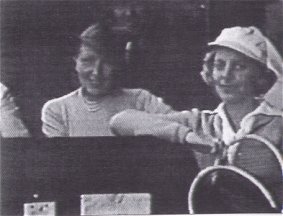
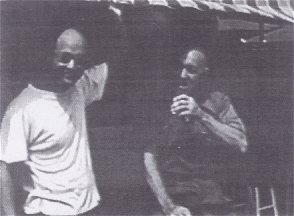
LEE: Oh, I think, fine until the very end. As I say, there
was always something going on. They had a lot of friends and they did a
lot of things together. Tennis was a co-sport and they played a lot of
mixed doubles and on and on. They were an extremely happy couple and enjoyed
each other thoroughly, as I say, up until just before we came back from
Hawaii.
FRANK: How many different residences can you recall living
at with your mother and Ed?
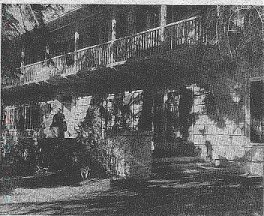
Photo courtesy of Grant
Menzies
806 N. Rodeo Drive
LEE: The first one I can remember was on Rodeo Drive in
Beverly Hills just south of Sunset Blvd. Then we moved up to the Sunset
Plaza apartments just north of Sunset Blvd. It's not there anymore but
it was a luxurious apartment complex; I remember Johnny Roselli, the gangster
lived there. From there we moved to 716 N. Rexford in Beverly Hills, a
nice home. It was leased unfurnished and mother and Ebbie furnished it.
And then, from there, we went to Hawaii, lived at Kailua Bay. When school
started we had to move over to the other side of the mountains. We had
a home up on Halelena St. in Manoa Valley (Honolulu) and attended Punahou
School. At the very end we moved down to the Niumalu Hotel for a short
period of time. Then things were getting a little rocky between Ebbie and
mother and shortly after that we boarded the ship and came back to Los
Angeles.
FRANK: Did you ever feel that Ed Burroughs was doing anything
that would make your mother unhappy in any way?
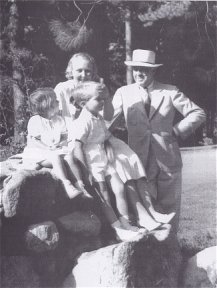 LEE:
They really didn't argue very much, certainly not in front of the children.
I remember that there were a lot of parties going on in Hawaii, and a lot
of drinking, and I think that probably was the biggest problem. Poor old
mother, you know, she was only like 5'4" and she had to wrestle either
the Pierce Arrow or the Packard, both big heavy cars, stick shifts, no
power steering, over the Pali Highway back to Kailua. I think all that
partying and drinking sort of got to her. It really was a pretty busy,
hectic life at the time. That, in my mind, was pretty much the cause of
the demise of the relationship.
LEE:
They really didn't argue very much, certainly not in front of the children.
I remember that there were a lot of parties going on in Hawaii, and a lot
of drinking, and I think that probably was the biggest problem. Poor old
mother, you know, she was only like 5'4" and she had to wrestle either
the Pierce Arrow or the Packard, both big heavy cars, stick shifts, no
power steering, over the Pali Highway back to Kailua. I think all that
partying and drinking sort of got to her. It really was a pretty busy,
hectic life at the time. That, in my mind, was pretty much the cause of
the demise of the relationship.
FRANK: According to Porges' biography there was a certain
incident that involved you and Ed that might have caused a crisis in the
relationship between your mother and Ed. Would you care to elaborate on
that?
LEE: I don't remember it - but if you want to bring it
up it's certainly all right with me and I'll see if I can help.
FRANK: Well, according to Porges (pg. 619), there was
an incident that occurred in Hawaii, probably in early 1941, that caused
you to be "quite afraid" of Ed. He must have chastised you for something
which caused you to be afraid. Supposedly, that is what caused your mother
Florence to reach a crisis point with Ed.
LEE: I would think I would remember if I was afraid of
him and I don't remember ever being afraid of him. He was very kind to
both my sister and me. He had a lot of other interests besides taking on
a couple of brats in a second family. But I have no remembrance of being
afraid of him at all. He wasn't a close, loving type of person, he was
very businesslike. But, no, I'm sure I would remember something like that.
And I don't think that some minor spat would have disturbed mother or the
relationship. I remember telling Irwin about once when I knocked a radio
off a table. I don't remember why I did it, probably some childish fit
of anger, but I don't remember the details.
Another time we were running around playing hide and seek
with a bunch of kids when I tripped over a water faucet and came down on
a rock and broke my arm. Ebbie was annoyed that he had to haul me to the
hospital and made some comment that I "must have a weak bone or something."
Mother took offense at that. But those kinds of things are very minor,
there was never anything major. If I remember that incident, I certainly
would remember something where he was mean to me and he never was. I don't
know where Porges got that. I have a copy of his book here somewhere -
I'll have to look it up.
FRANK: Porges also pointed out that Ed Burroughs developed
a close, fatherly relationship with your sister.
LEE: I think much closer than he did with me. I was more
set in my ways and here we were, sort of kicked around between pillar and
post, changing schools all the time, which didn't help a lot with our education.
She was younger, and a girl, and she related to him a little closer than
I did.
FRANK: What led to Ed's decision to send you to the Hollywood
Military Academy?
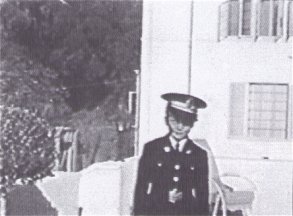 LEE:
Well, you know, he had been in the military and thought that a military
school was a good way to raise a young man. I think I was a little young
for it. Hollywood Military Academy was, in my opinion, and, I believe,
in other people's opinions as well - which was the reason I didn't stay
there - a place where people send kids to get rid of them, to put them
out to pasture. That didn't work out at all.
LEE:
Well, you know, he had been in the military and thought that a military
school was a good way to raise a young man. I think I was a little young
for it. Hollywood Military Academy was, in my opinion, and, I believe,
in other people's opinions as well - which was the reason I didn't stay
there - a place where people send kids to get rid of them, to put them
out to pasture. That didn't work out at all.
FRANK: How old were you when you went to the Hollywood
Military Academy?
LEE: Oh, I would guess about the third grade, so
somewhere around seven or eight years old. It was mostly older kids there.
We had only a very few kids my age. It probably would have been a good
experience if I'd been a little older. I don't think the reason I was sent
there was particularly to get rid of me. Because, first of all, Ebbie wasn't
around that much. We had servants that took care of us. There was a nurse,
a cook, and a chauffeur/butler. We were taken to school in the big Packard
and so forth. This was the middle of the Depression.
FRANK: Did you and Ed ever go anywhere, as father
and son, just for the fun of it?
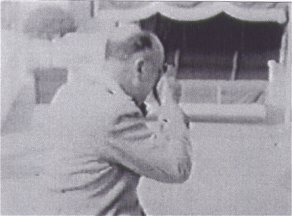 LEE:
I can remember mother once saying to Ebbie: "You know, you ought to take
Lee to a baseball game or something, be more of a father." His response
was a rather grumpy "Well okay, I'll do it." So we went off to Wrigley
Field here in Los Angeles. We got there late, the place was sold out and
we couldn't get in. So Ebbie said "Well, now what do you want to do?" And
I said, "What do you want to do?" So the Goodyear blimp happened to be
flying from the airport which, in those days, was between 3rd and 6th St.
at Fairfax Ave. To make a long story short, we went up in the Goodyear
blimp which was a big thrill and I think both of us enjoyed it.
When we got home there was hell to pay. Mother's reaction was: "You took
him up in that old blimp? That thing might have crashed! You were supposed
to go to the baseball game!" That was something that stuck in my mind,
more amusing than anything serious. It was my first ride in a lighter than
air craft. It went out over the beach and around and lasted about an hour.
It was a lot of fun! But Ebbie didn't do things with us very often. I remember
being in the Cub Scouts and having baseball games in Griffith Park. He'd
grudgingly go to those things. He really had better things to do and I
don't blame him. Suzanne and I have three children and four grandsons and
I know just exactly how it is.
LEE:
I can remember mother once saying to Ebbie: "You know, you ought to take
Lee to a baseball game or something, be more of a father." His response
was a rather grumpy "Well okay, I'll do it." So we went off to Wrigley
Field here in Los Angeles. We got there late, the place was sold out and
we couldn't get in. So Ebbie said "Well, now what do you want to do?" And
I said, "What do you want to do?" So the Goodyear blimp happened to be
flying from the airport which, in those days, was between 3rd and 6th St.
at Fairfax Ave. To make a long story short, we went up in the Goodyear
blimp which was a big thrill and I think both of us enjoyed it.
When we got home there was hell to pay. Mother's reaction was: "You took
him up in that old blimp? That thing might have crashed! You were supposed
to go to the baseball game!" That was something that stuck in my mind,
more amusing than anything serious. It was my first ride in a lighter than
air craft. It went out over the beach and around and lasted about an hour.
It was a lot of fun! But Ebbie didn't do things with us very often. I remember
being in the Cub Scouts and having baseball games in Griffith Park. He'd
grudgingly go to those things. He really had better things to do and I
don't blame him. Suzanne and I have three children and four grandsons and
I know just exactly how it is.
FRANK: Did you ever go up with Ed in his airplane?
LEE: No, I was never allowed to do that. I thought
that would have been fun. But I can remember seeing him flying high above
the Sunset Plaza apartments on Sunset Strip making slow circles and we'd
watch him. Mother wouldn't go up with him and, certainly she wouldn't let
her children go up with him. So he flew alone or with an instructor. He
had an airplane but I don't remember him having it very long, maybe a year
or so. It was sort of one of his many passing fancies.
FRANK: What did you think of John Taliaferro's recent
ERB biography,
Tarzan Forever.
LEE: I didn't really enjoy that as much as I did Irwin's.
I thought that, mainly, his book was just a compilation of all the other
things that had already been done. He came by for an interview too, but
it was a very short one. There were a lot of minor mistakes such as his
referring to Dr. Chase as "Alfred" Chase. His name was Albert Stillman
Chase.
FRANK: Did Taliaferro say anything that you found to be
untrue?
LEE: Not that I can remember.
FRANK: Did you ever see your father Ashton Dearholt after
your mother's divorce from him?
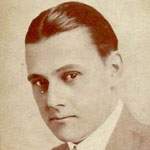 LEE:
Well, when we were extremely small, evidently he was around once in awhile.
But neither my sister nor I can remember seeing him. He had done a real
estate development very similar to Farmers Market called Marketville, just
north of Farmers Market, which didn't pan out. I think the war came along
and squelched that. When we came back from Hawaii we went down there with
mother to see it and he was there. I remember saying "hi" to him. My sister
remembers going but she doesn't remember talking to him. So you might say
virtually no contact. When he died he left me some memorabilia, guns and
spears and stuff that a teenager would enjoy, and that was about it.
LEE:
Well, when we were extremely small, evidently he was around once in awhile.
But neither my sister nor I can remember seeing him. He had done a real
estate development very similar to Farmers Market called Marketville, just
north of Farmers Market, which didn't pan out. I think the war came along
and squelched that. When we came back from Hawaii we went down there with
mother to see it and he was there. I remember saying "hi" to him. My sister
remembers going but she doesn't remember talking to him. So you might say
virtually no contact. When he died he left me some memorabilia, guns and
spears and stuff that a teenager would enjoy, and that was about it.
FRANK: According to Irwin Porges' biography, Ed kept up
a correspondence with your sister Caryl Lee.
LEE: Yes, some. She could answer that better than I could.
She was very fond of him and kept writing and calling him. Maybe once or
twice he came over and they went to have lunch. He and I would say "hello."
We were polite but reserved. She was more fond of him. But he gradually
drifted away from that relationship, which is too bad, but that's life.
FRANK: Apparently he was sending her gifts and things
from Hawaii when he was a war correspondent during World War II. I was
wondering if she may still have some other items?
LEE: She may very well. She was probably better at that
sort of thing than I was. When mother died my sister kept most of her things,
including the family records. There were just a couple of pieces of furniture
that I wanted. Uncle Eddie, who is now gone too, has all the books and
Tarzan stuff.
FRANK: He operated a bookstore, did he not?
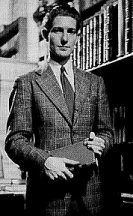

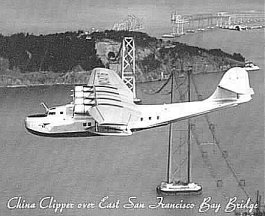
LEE: Yes, Gilbert's Books up at Hollywood and Vine, for
many years. Uncle Eddie was in the first graduating class of UCLA, an avid
reader, and was a good buddy of Ebbie. He had that bookshop until he retired
and it wasn't all that long ago. Maybe ten years ago. Originally the shop
was located right next to the Brown Derby on Vine.
FRANK: You had mentioned previously that your mother and
Ed took some secret vacations.
LEE: Mother and Ebbie were good friends who got together
and ended up getting married. I think at the very beginning when Ashton
Dearholt came home from Guatemala and had had his fling or affair with
Ula Holt, that sort of ended the marriage. I think even before he came
back from Guatemala the rumors spread. At that time it was all sort of
"sticky wicked" with all the divorces, Ebbie's divorce, and Ashton's and
Florence's divorce, young kids in the picture, the whole bit. Of course,
they were hounded by the news media wherever they went. About 1937 mother
and Ebbie took off sort of secretly and flew on the China Clipper out of
San Francisco to Hawaii. I remember mother saying that there were wicker
seats and under the wicker seats were four shoe boxes. The four shoe boxes
held your four meals because the flight took 24 hours. The big engines
were so loud, mother said, that the people who went on to Midway, Wake
Island, Manila and Hong Kong must have been stone deaf when they got there.
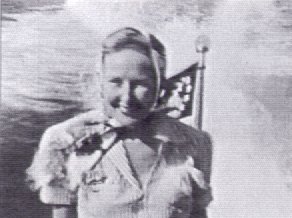
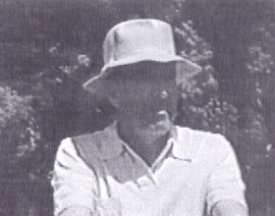 FRANK: Did your mother and Ed go to China?
FRANK: Did your mother and Ed go to China?
LEE: I suspected they went to China but I never knew it
for sure. There are some artifacts, in fact, two of them are in our dining
room, that came from China. I had a great picture of Ebbie standing in
front of the Packard on a pier. Behind him was a ship called the Empress
of Japan. They did take a voyage on that ship and they took the Packard
with them. Where exactly they all went I don't know. There were some trips
that the children where not part of. I think the Empress of Japan cruise
went through the Panama Canal. I do know they ended up in New York. The
Packard was a new 1937 model and they drove it home.
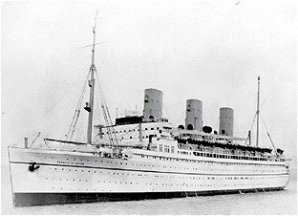
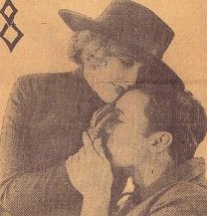
Empress of Japan ~ Florence with George O'Brian in
The Johnstown Flood
FRANK: Your mother starred in a film called The Johnstown
Flood.
LEE: Yes, I guess you could call her the star of that
film. That was also the film that introduced Janet Gaynor, who was a good
friend of mother. She had all kinds of friends in the business, Rochelle
Hudson and Mary Martin, others that I can remember back before the War.
That was one of her last pictures. Uncle Eddie got me a copy of that and
a couple other of her films. She did twenty or thirty films, all of them
silent.
FRANK: Do they all still exist somewhere?
LEE: Uncle Eddie tried to research that. He even found
a couple of them in Czechoslovakia, of all places. Evidently they have
quite a film library over there of early silent films. Mother was really
on her way up as far as being a movie actress. When talkies came in, in
1927, that's when she was married and gave up her acting career. Then she
had children. She kept us pretty well sheltered from the movie crowd which
was a little fast and a little racy in those days. I remember Ralph Bellamy
and some other people who occasionally visited us. Or we visited them.
But not a lot.
FRANK: Would you like to say anything else about Ed Burroughs
as a father?
LEE: Well, as I recall, he wasn't around a lot or very
active as a father. He was there but he was very busy with his business.
Either he was writing or he was out arguing with people about what should
be in his movies or what shouldn't. That and the very extensive social
life. He wasn't the kind of guy who was there for every swim meet and baseball
and football game.
FRANK: I guess that's understandable.
LEE: Yes it is, it certainly is. He'd raised his family
and he was off now to have a good time. And, by golly, he did and more
power to him.
FRANK: When did your mother pass away?
LEE: Oh, gosh, it's been several years. She was living
with my sister in the San Fernando Valley. Of course, we saw a lot of her.
She came here for all the holidays, Christmas, and all. She didn't have
cancer or anything like that. She just wore out, died of old age. She was
stubborn until the end. She was in the hospital and the doctors said they
could prolong her life. But she didn't want that. She wanted to go home
and be with her books and television. And that's what happened. She lasted
another three or four months and that was it.
FRANK: May I inquire as to her final resting place?
LEE: Mother belonged to the Neptune Society, which is
a pre-paid cremation service. You can have your ashes spread out over Santa
Monica Bay from the good ship Neptune, or you can have them put down at
the Rose Garden, a beautiful floral display at Exposition Park down by
the coliseum near USC. Mother loved flowers so she chose the Rose Garden.
My sister, who has been an animal trainer since she was a kid, has a few
of her very favorite animals, her favorite horse and a couple of famous
movie dogs she trained, in little urns up on her mantle in her home. I
can remember my mother half-jokingly saying to me, "Promise me one thing
-- that you won't let Cindy put me up on the mantle with the rest of the
animals." And I said, "Yes, mother, I promise." So she was cremated and
went to the Rose Garden.
FRANK: Thank you for sharing your very personal memories.
I would like to ask you now about Edgar Rice Burroughs' books. Do you recall
the circumstances of when you first began reading them? Do you remember
which was the first of Ed's novels that you read?
LEE: The first one I read was Tarzan of the Apes,
the first Tarzan book. This was when we were over in Kailua, Hawaii, about
1940. I was mumbling and grumbling about having nothing to read. And I
remember Ebbie saying, "Well, maybe he would enjoy some of my books." I
was very enthusiastic about that because all I'd read were the funny papers
up until then. So I started through the Tarzan series. The tarzan books,
to me, were very real. Of course, it took a long time to get through all
of his books up till that time. I think my favorites, in all fairness were
the John Carter books. I read everything he ever did in the way of books.
Not his early magazine articles, I didn't have access to those. I wish
I had requested and had a copy of every one of his books, but I didn't.
FRANK: You weren't as much a collector type as your Uncle
Eddie?
LEE: Not at all. Uncle Eddie was the family collector.
I was an avid reader - still am.
FRANK: The first Tarzan book that you read was given to
you by Ed Burroughs?
LEE: Yes, I still have it. It's over there on the bookshelf.
FRANK: It's an A.L. Burt reprint edition of Tarzan
of the Apes. I'd like to take a photograph of you holding it later.
LEE: You're welcome to do that. It's well worn, it's been
read by a lot of people. The kids read it and I think I loaned it to two
or three friends years and years ago. We were always trading books around
back in school.
FRANK: It's been fifty some years now since Ed passed
away. There are several clubs and organizations that are dedicated to his
writings and his books are quite valuable in the collector's market. How
long do you think that people will continue to read the novels of Edgar
Rice Burroughs?
LEE: Oh, I think -- I should live so long! -- that will
go on forever as far as I'm concerned. Things keep popping up. Disney just
did the animated Tarzan movie. Other people do this and that. The stories
have been around for nearly a hundred years now and certainly will
go on ad infinitum. Those are fascinating, fascinating books.
FRANK: So you feel that they have a timeless quality?
LEE: Yes, I think timeless, absolutely. You get into those
books and you're there. You're into that era, you're on Mars, you're
in the jungle. I always liked the way the story never really ended. There
was always another book coming and everybody waited and waited. It was
the same way with Sunday Los Angeles Times. Tarzan was on
the front page of the comics section, which was the first thing you saw
when you picked up the Times each Sunday. All the kids at school
would say to me, "Well, you must know what's going to happen!" And, of
course, I'd fake it or whatever. But I liked the continuity of it. The
stories just went on and on and on -- and I think they will continue to
do that.
FRANK: I feel the same way. I think that as long as people
still read books they will always read Edgar Rice Burroughs.
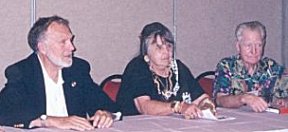
Lee, Caryl Lee & Uncle Eddie at the 1999 Tarzana
Dum-Dum
LEE: Yes, I certainly feel that way. When the Burroughs
Bibliophiles held their Dum-Dum here in the San Fernando Valley a few years
ago, Uncle Eddie, my sister and I were asked to be on the panel. We went
and we enjoyed it thoroughly. That's the only time my sister or I have
participated in something like that. They had a swap meet there with
a lot of Burroughs books, memorabilia, movie posters, etc. I bought a couple
of posters for my daughter who lives in Colorado. My other son, who lives
near Chicago, is looking for a couple of the Dearholt movie posters which
I haven't been able to find for him yet.
I do receive The Burroughs Bulletin, complimentary
from Louisville, which I look at every time. It's nice of them to send
me that and I appreciate it. The local fans (LA Sub-ERBs) had said that
if they have another meeting out here, they'd like me to attend again because
they liked my stories. I said, "Well, I just live over the hill and I'd
be happy to be of whatever help I can." Because my sister and I are about
the last people that actually lived with Edgar Rice Burroughs, even though
it was just for a few years.
FRANK: I feel very privileged that you've shared your
memories with me and with The Burroughs Bibliophiles. Thank you so much.
LEE: It's my pleasure. The years spent with Ebbie were
a highlight of my life, certainly.
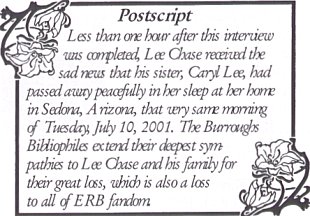

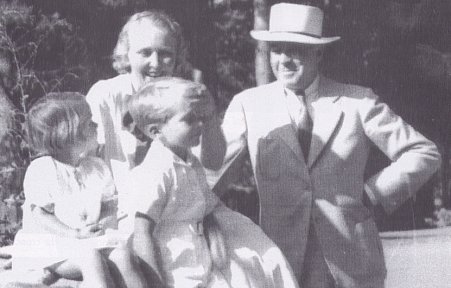
 I
first met Lee Chase at his son Steven's home in Tucson, Arizona, on December
24, 2000. At that time he graciously shared with me some home movies made
by his mother, silent film actress Florence Gilbert, in the late 1930s
and early 1940s during her marriage to Edgar Rice Burroughs. Lee gave a
running commentary while the film played and I watched enthralled as animated
images of our favorite author with family and friends, against a background
of California and Hawaii, carried us back in time. Lee Chase was nearing
his sixth birthday when his mother and Ed Burroughs were married in April,
1935. Lee's memories of ERB date from the time he was approximately age
six to about age twelve, the years of his mother's and Ed's marriage: 1935
to 1942.
I
first met Lee Chase at his son Steven's home in Tucson, Arizona, on December
24, 2000. At that time he graciously shared with me some home movies made
by his mother, silent film actress Florence Gilbert, in the late 1930s
and early 1940s during her marriage to Edgar Rice Burroughs. Lee gave a
running commentary while the film played and I watched enthralled as animated
images of our favorite author with family and friends, against a background
of California and Hawaii, carried us back in time. Lee Chase was nearing
his sixth birthday when his mother and Ed Burroughs were married in April,
1935. Lee's memories of ERB date from the time he was approximately age
six to about age twelve, the years of his mother's and Ed's marriage: 1935
to 1942.
 LEE:
The first child of Ashton Dearholt and Florence Gilbert Dearholt. I have
a sister named Caryl Lee, she goes by "Cindy" now but her birth certificate
would read Caryl Lee Dearholt.
LEE:
The first child of Ashton Dearholt and Florence Gilbert Dearholt. I have
a sister named Caryl Lee, she goes by "Cindy" now but her birth certificate
would read Caryl Lee Dearholt.
 LEE:
Suzanne and I met in high school. She went to Marlborough School here in
Los Angeles; I was at L.A. High. We dated off and on for years and, finally,
in 1953 on Valentine's Day we were married. We've been married forty-eight
and a half years, currently.
LEE:
Suzanne and I met in high school. She went to Marlborough School here in
Los Angeles; I was at L.A. High. We dated off and on for years and, finally,
in 1953 on Valentine's Day we were married. We've been married forty-eight
and a half years, currently.
 LEE:
Very much so. We, of course, went to school over there, at Punahou. But
everyone pretty much knew the war was coming. They didn't know when and
they didn't know where - but they knew we were going to have problems.
We had practice blackouts. I remember even at school we had our little
bags with soap and a blanket and stuff, in case we had to stay overnight.
Then, when it looked like things were really heating up, we came home.
Went over on the S.S. Lurline, and came home on the S.S. Mariposa,
two of three ships that the Matson Line was running then. The Monterey,
the
Mariposa
and
the Lurline, which were pretty fancy boats in those days.
LEE:
Very much so. We, of course, went to school over there, at Punahou. But
everyone pretty much knew the war was coming. They didn't know when and
they didn't know where - but they knew we were going to have problems.
We had practice blackouts. I remember even at school we had our little
bags with soap and a blanket and stuff, in case we had to stay overnight.
Then, when it looked like things were really heating up, we came home.
Went over on the S.S. Lurline, and came home on the S.S. Mariposa,
two of three ships that the Matson Line was running then. The Monterey,
the
Mariposa
and
the Lurline, which were pretty fancy boats in those days.



 LEE:
They really didn't argue very much, certainly not in front of the children.
I remember that there were a lot of parties going on in Hawaii, and a lot
of drinking, and I think that probably was the biggest problem. Poor old
mother, you know, she was only like 5'4" and she had to wrestle either
the Pierce Arrow or the Packard, both big heavy cars, stick shifts, no
power steering, over the Pali Highway back to Kailua. I think all that
partying and drinking sort of got to her. It really was a pretty busy,
hectic life at the time. That, in my mind, was pretty much the cause of
the demise of the relationship.
LEE:
They really didn't argue very much, certainly not in front of the children.
I remember that there were a lot of parties going on in Hawaii, and a lot
of drinking, and I think that probably was the biggest problem. Poor old
mother, you know, she was only like 5'4" and she had to wrestle either
the Pierce Arrow or the Packard, both big heavy cars, stick shifts, no
power steering, over the Pali Highway back to Kailua. I think all that
partying and drinking sort of got to her. It really was a pretty busy,
hectic life at the time. That, in my mind, was pretty much the cause of
the demise of the relationship.
 LEE:
Well, you know, he had been in the military and thought that a military
school was a good way to raise a young man. I think I was a little young
for it. Hollywood Military Academy was, in my opinion, and, I believe,
in other people's opinions as well - which was the reason I didn't stay
there - a place where people send kids to get rid of them, to put them
out to pasture. That didn't work out at all.
LEE:
Well, you know, he had been in the military and thought that a military
school was a good way to raise a young man. I think I was a little young
for it. Hollywood Military Academy was, in my opinion, and, I believe,
in other people's opinions as well - which was the reason I didn't stay
there - a place where people send kids to get rid of them, to put them
out to pasture. That didn't work out at all.
 LEE:
I can remember mother once saying to Ebbie: "You know, you ought to take
Lee to a baseball game or something, be more of a father." His response
was a rather grumpy "Well okay, I'll do it." So we went off to Wrigley
Field here in Los Angeles. We got there late, the place was sold out and
we couldn't get in. So Ebbie said "Well, now what do you want to do?" And
I said, "What do you want to do?" So the Goodyear blimp happened to be
flying from the airport which, in those days, was between 3rd and 6th St.
at Fairfax Ave. To make a long story short, we went up in the Goodyear
blimp which was a big thrill and I think both of us enjoyed it.
When we got home there was hell to pay. Mother's reaction was: "You took
him up in that old blimp? That thing might have crashed! You were supposed
to go to the baseball game!" That was something that stuck in my mind,
more amusing than anything serious. It was my first ride in a lighter than
air craft. It went out over the beach and around and lasted about an hour.
It was a lot of fun! But Ebbie didn't do things with us very often. I remember
being in the Cub Scouts and having baseball games in Griffith Park. He'd
grudgingly go to those things. He really had better things to do and I
don't blame him. Suzanne and I have three children and four grandsons and
I know just exactly how it is.
LEE:
I can remember mother once saying to Ebbie: "You know, you ought to take
Lee to a baseball game or something, be more of a father." His response
was a rather grumpy "Well okay, I'll do it." So we went off to Wrigley
Field here in Los Angeles. We got there late, the place was sold out and
we couldn't get in. So Ebbie said "Well, now what do you want to do?" And
I said, "What do you want to do?" So the Goodyear blimp happened to be
flying from the airport which, in those days, was between 3rd and 6th St.
at Fairfax Ave. To make a long story short, we went up in the Goodyear
blimp which was a big thrill and I think both of us enjoyed it.
When we got home there was hell to pay. Mother's reaction was: "You took
him up in that old blimp? That thing might have crashed! You were supposed
to go to the baseball game!" That was something that stuck in my mind,
more amusing than anything serious. It was my first ride in a lighter than
air craft. It went out over the beach and around and lasted about an hour.
It was a lot of fun! But Ebbie didn't do things with us very often. I remember
being in the Cub Scouts and having baseball games in Griffith Park. He'd
grudgingly go to those things. He really had better things to do and I
don't blame him. Suzanne and I have three children and four grandsons and
I know just exactly how it is.
 LEE:
Well, when we were extremely small, evidently he was around once in awhile.
But neither my sister nor I can remember seeing him. He had done a real
estate development very similar to Farmers Market called Marketville, just
north of Farmers Market, which didn't pan out. I think the war came along
and squelched that. When we came back from Hawaii we went down there with
mother to see it and he was there. I remember saying "hi" to him. My sister
remembers going but she doesn't remember talking to him. So you might say
virtually no contact. When he died he left me some memorabilia, guns and
spears and stuff that a teenager would enjoy, and that was about it.
LEE:
Well, when we were extremely small, evidently he was around once in awhile.
But neither my sister nor I can remember seeing him. He had done a real
estate development very similar to Farmers Market called Marketville, just
north of Farmers Market, which didn't pan out. I think the war came along
and squelched that. When we came back from Hawaii we went down there with
mother to see it and he was there. I remember saying "hi" to him. My sister
remembers going but she doesn't remember talking to him. So you might say
virtually no contact. When he died he left me some memorabilia, guns and
spears and stuff that a teenager would enjoy, and that was about it.









